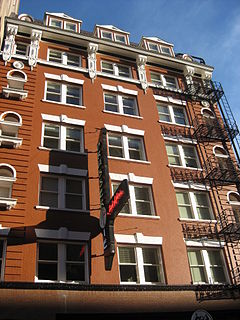
Civic Stadium was an outdoor athletic stadium in the western United States, located in Eugene, Oregon. For most of its history it was owned by the Eugene School District. Opened in 1938, the stadium was destroyed by fire in 2015 on June 29.

Herron–Morton Place is a historic district in Indianapolis, Indiana, dedicated to restoration and renewal. The boundaries of the neighborhood are East 16th Street on the south, East 22nd Street on the north, the alley west of North Pennsylvania on the west, and Central Avenue on the east.

Mihran Mesrobian was an Armenian-American architect whose career spanned over fifty years and in several countries. Having received an education in the Academy of Fine Arts in Constantinople, Mesrobian began his career as an architect in Smyrna and in Constantinople. While in Constantinople, Mesrobian served as the palace architect to the last Ottoman Sultan, Mehmed V.

Douglaston Historic District is a national historic district in Douglaston, Queens, New York. It includes 631 contributing buildings and three contributing sites on a mile-long peninsula extending into Little Neck Bay. All but one of the buildings are in residential use and the majority were built in the early- to mid-20th century as a planned suburban community known as Douglas Manor. In the early 20th century, the Rickert-Finlay Realty Company of Manhattan purchased 175 acres (0.71 km2) of the Douglas' family holdings, and formed the Douglas Manor Association, creating a planned community. Many of the houses in this area were built in architectural styles popular at the time, such as Tudor, Mediterranean, Colonial Revival, and Arts and Crafts. Located within the district are the separately listed Cornelius Van Wyck House and Allen-Beville House. Another notable early building is the Van Zandt manor house, which is now the Douglaston Club.

The Murray Downtown Residential Historic District is the best representative area of the residential settlement and development of the city of Murray, Utah, United States. It was listed on the National Register of Historic Places in 2005. It is locally significant as a physical reflection of its residential architecture and the historic development of the city from its agricultural beginnings through its industrial era and current status as a small suburban city. The buildings within the district represent the wide range of architectural styles and plans popular in the city and the state of Utah between 1870 and 1954 and retain a high degree of integrity.

Emil Schacht was a prominent architect in Portland, Oregon. Schacht's work was prolific from the 1890s until World War I and he produced commercial buildings including factories and warehouses as well as residential projects, hotels and theatres. He is known for his craftsman architecture stlyle homes and was a founding member of the 1902 Portland Association of architects.

The Jacob Kamm House, also called the Jacob Kamm Mansion, is a French Second Empire style mansion in Portland, Oregon, built in 1871. It was moved from its original location on SW 14th and Main to its current location in Goose Hollow in 1950 to make room for Lincoln High School's campus. It was purchased by preservationist Eric Ladd for $1,000 at auction and moved to its present location, along with two other houses Ladd was interested in preserving, at SW 20th and Jefferson, which was called "the colony."

Clarksville Methodist Church is a historic church building at 334 Main Street in Clarksville, Tennessee. Currently, the building isn't used as a church.

The Calumet Hotel, also known as the Esquire Hotel, is a former hotel building located in downtown Portland, Oregon, that is listed on the National Register of Historic Places. The building was changed from a commercial hotel to a residential hotel for low-income residents in the 1930s. At some point, it took the name Esquire Hotel. By the time of its nomination to the National Register, in 1983, it was vacant. The building was renovated in 2008–09 and is now known as "The Esquire" apartments.

The Jeanne Manor Apartment Building is a seven-story apartment hi-rise located in downtown Portland, Oregon, in the United States, listed on the National Register of Historic Places. Architects Bennes and Herzog finished the Art Deco structure in 1931. The Jeanne Manor faces the South Park Blocks at the corner of Southwest Park Avenue and Clay Street.

The Campbell Hotel, located in northwest Portland, Oregon, is a historic former residential hotel that is listed on the National Register of Historic Places (NRHP). It is now an apartment building named the Campbell Court Apartments.

The Rice Apartments are a historic apartment building in Eugene, Oregon, United States.

The Avery–Helm Historic District comprises a primarily residential portion of central Corvallis, Oregon, United States. Located on several of Corvallis's earliest plats, the 122 historic houses remaining in the district present a window into the domestic aspects of the city's development from 1870 to 1949, providing a full industrial, socioeconomic, and architectural profile of that period. The district was added to the National Register of Historic Places in 2000.

Gerlinger Hall is a historic building on the University of Oregon campus in Eugene, Oregon as part of the Women's Memorial Quadrangle. For the first time, enough women were attending the University that they could occupy their own full quadrangle.
Fiske & Meginnis, Architects was an architecture firm partnership from 1915–1924 between Ferdinand C. Fiske (1856–1930) and Harry Meginnis in Lincoln, Nebraska. Twelve of the buildings they designed are listed on the National Register of Historic Places (NRHP). The two men have additional buildings listed on the National Register with other partnerships or individually credited. Related firms were Fiske and Dieman, Fiske, Meginnis and Schaumberg, and Meginnis and Schaumberg.

Sheffield Inn, also known as the Sheffield Apartments, is a historic apartment building located at Indianapolis, Indiana. It was built in 1927, and is a two-story, "I"-shaped Tudor Revival style masonry building. It features a multi-gabled slate roof with 2½-story projecting gabled pavilion, decorative chimney, banks of leaded glass windows, and decorative half-timbering. The building was originally designed as a residential hotel and remodeled in 1971. It is located immediately next to the Manchester Apartments.

Shortridge–Meridian Street Apartments Historic District is a national historic district located at Indianapolis, Indiana. The district encompasses 136 contributing buildings in a predominantly residential section of Indianapolis. It was developed between about 1900 and 1951, and includes representative examples of Colonial Revival, Classical Revival, Late Gothic Revival, Mission Revival, Renaissance Revival, Bungalow / American Craftsman, and Art Deco style architecture. Located in the district is the separately listed Shortridge High School. Other notable buildings include the Vernon Court Apartments (1928), Fronenac Apartments (1951), Biltmore Apartments (1927), Meridian Apartments (1929), New Yorker Apartments (1917), Howland Manor (1929), Powell-Evans House (1911), Harms House (1906), Dorchester Apartments (1921), and Martin Manor Apartments (1916).

The 705 Davis Street Apartments is a historic residential building located at 2141 Northwest Davis Street in Portland, Oregon, in the United States. It was designed by Morris H. Whitehouse and J. André Fouilhoux via the firm Whitehouse & Fouilhoux, and was completed in 1913. The building was added to the National Register of Historic Places on October 10, 1980.

The Cornell College-Mount Vernon Historic District is a nationally recognized historic district located in Mount Vernon, Iowa, United States. It was listed on the National Register of Historic Places in 1980. The district embraces the campus of Cornell College and the residential area that surrounds it. It is composed of 120 buildings and structures, of which 70 are residential. There are also a couple of churches on the east side of the district, and an old hotel was converted into apartments.

The C.H. Baker Double House, also known as the Indiana Apartments, The Manor, and The Manor House, is an historic building located in Des Moines, Iowa, United States. Built from 1901 to 1902, it is a two-story structure that features balloon frame construction with brick veneer. It was designed in the Colonial Revival style by the Des Moines architectural firm of Smith & Gutterson. Its significance is attributed to its location on the Sixth Avenue streetcar route "to capitalize on the appeal of public transportation." It was one of the first multiple-family rental properties along the avenue, and it was built for upper-middle class occupancy. It was part of the movement toward denser residential use in this area of the city. The house was listed on the National Register of Historic Places in 1996.





















